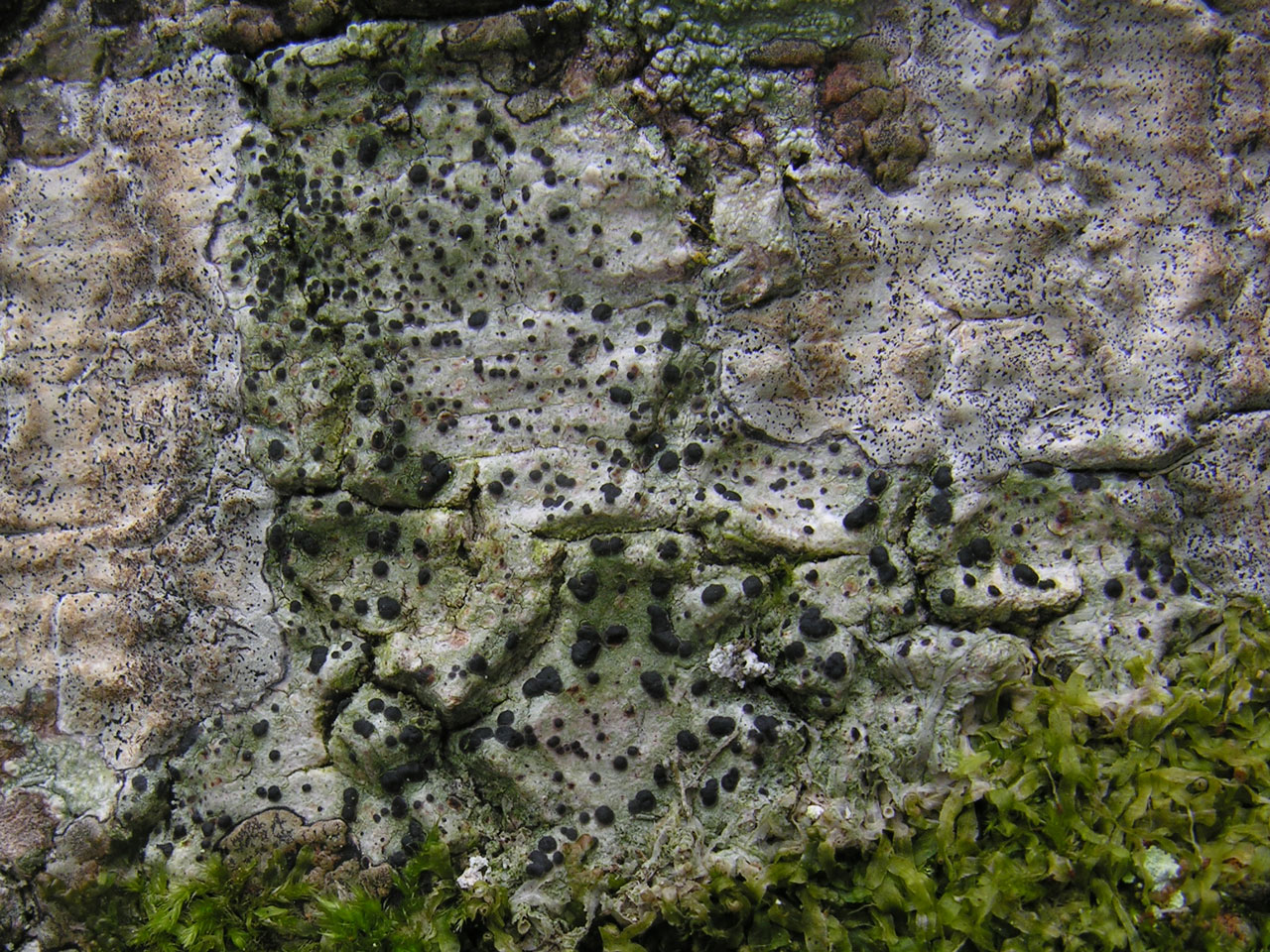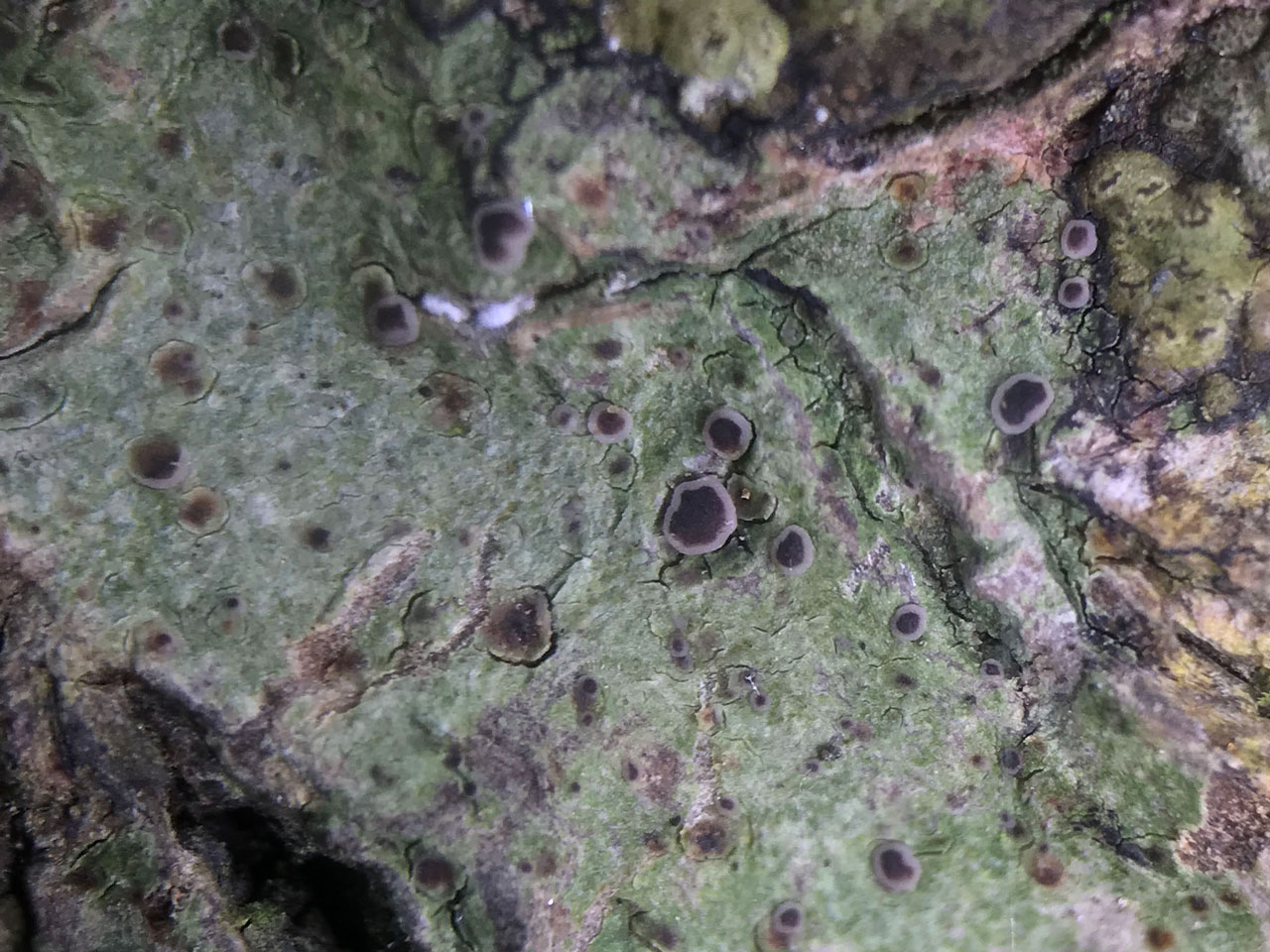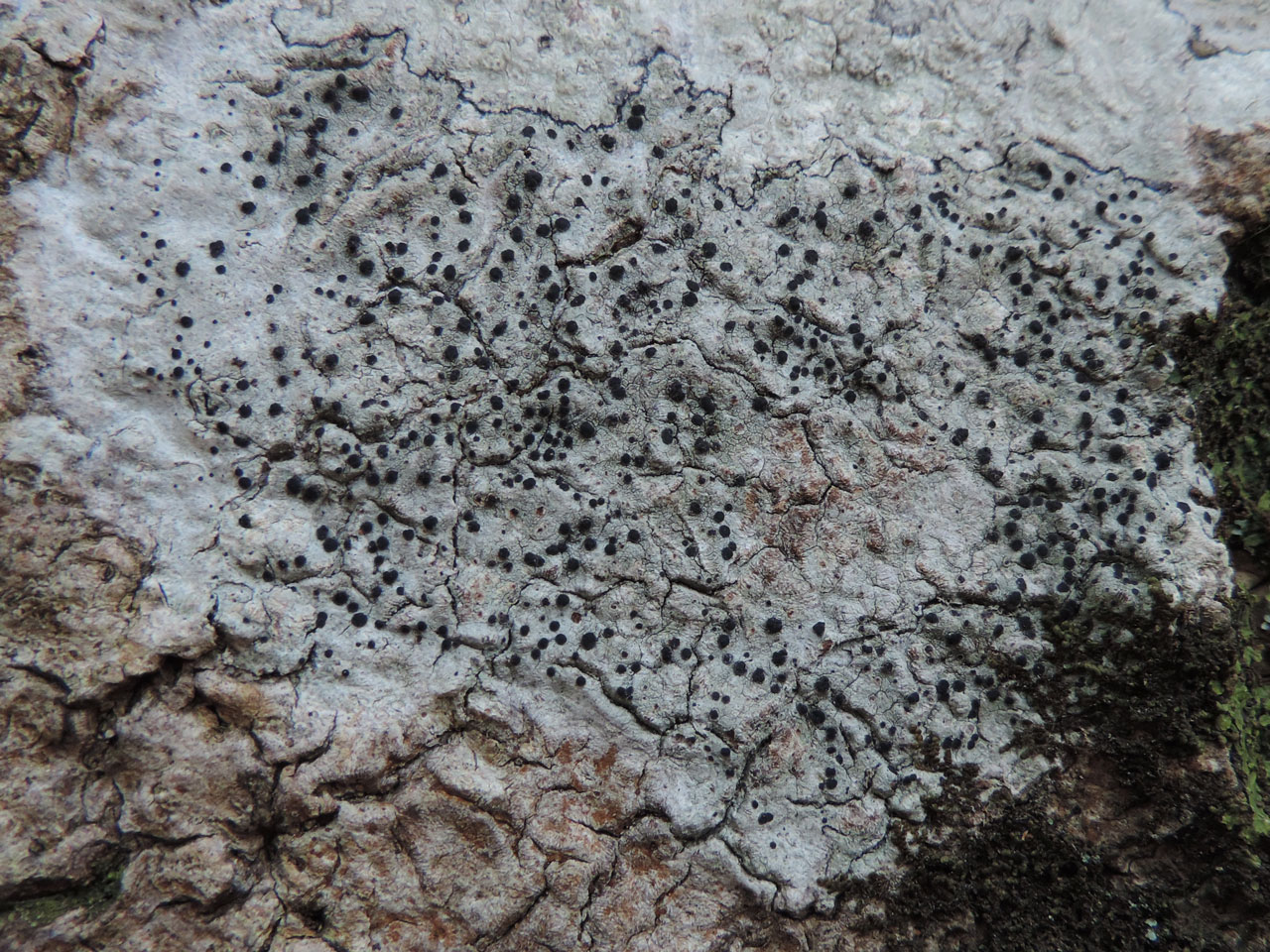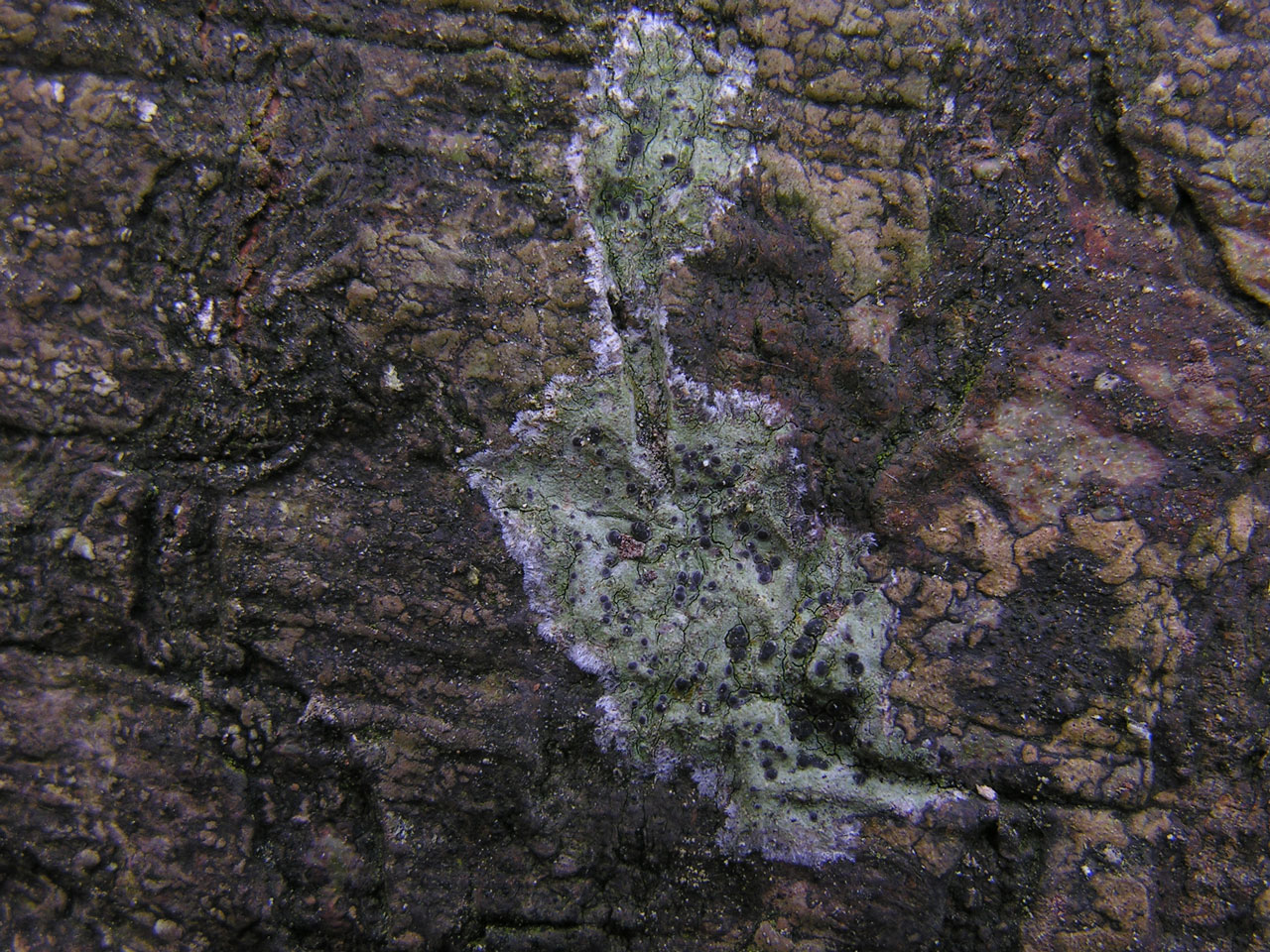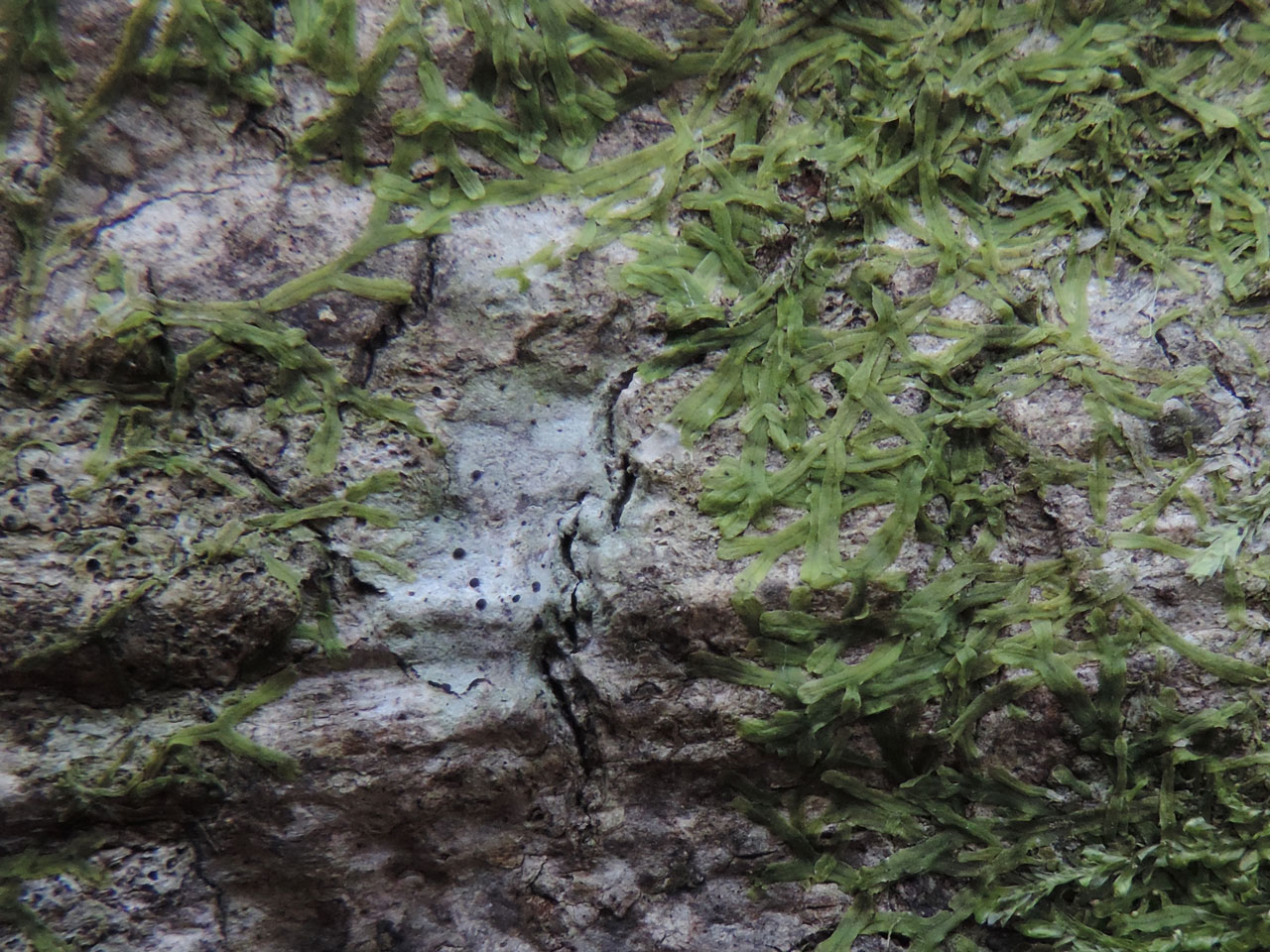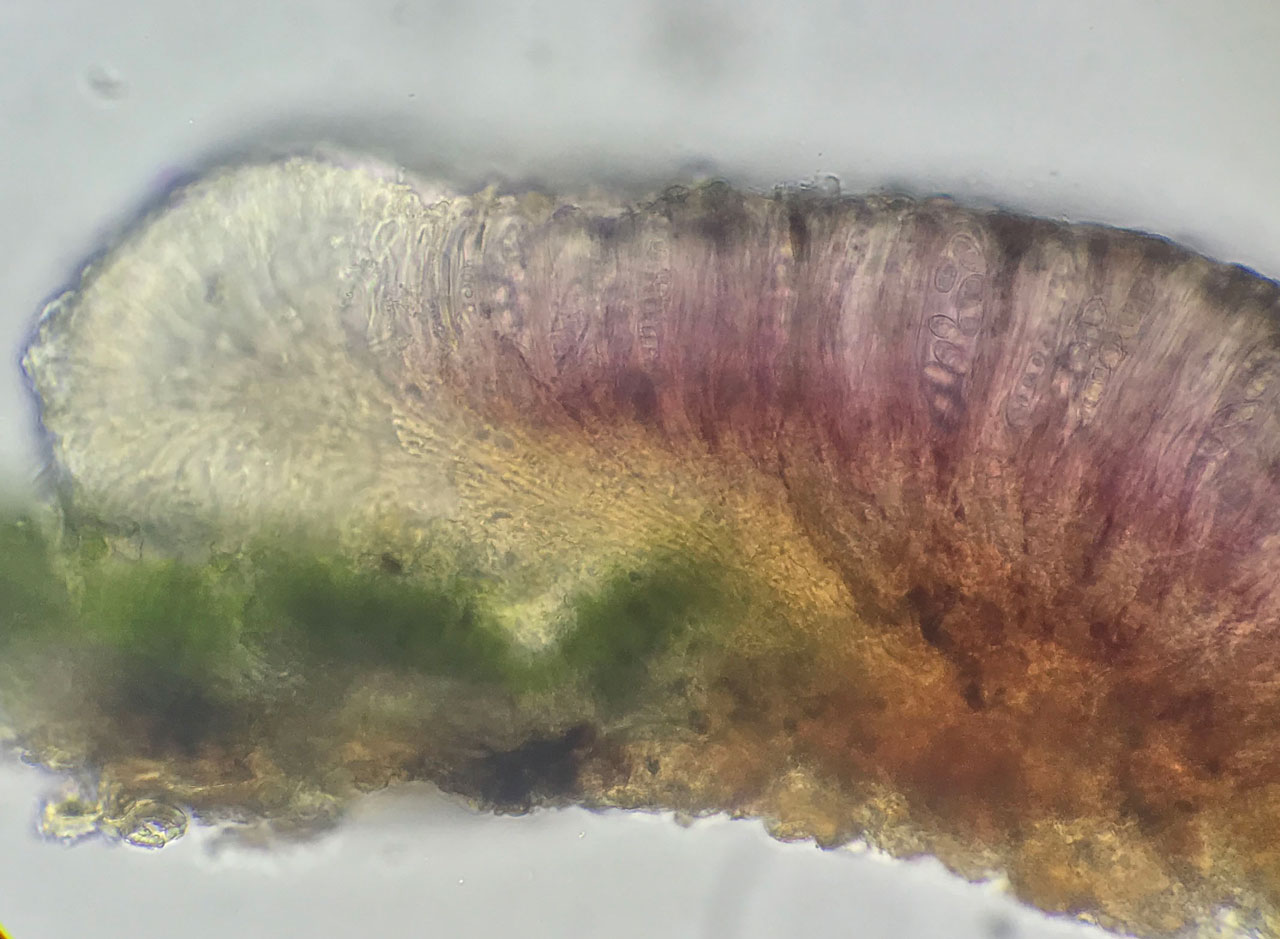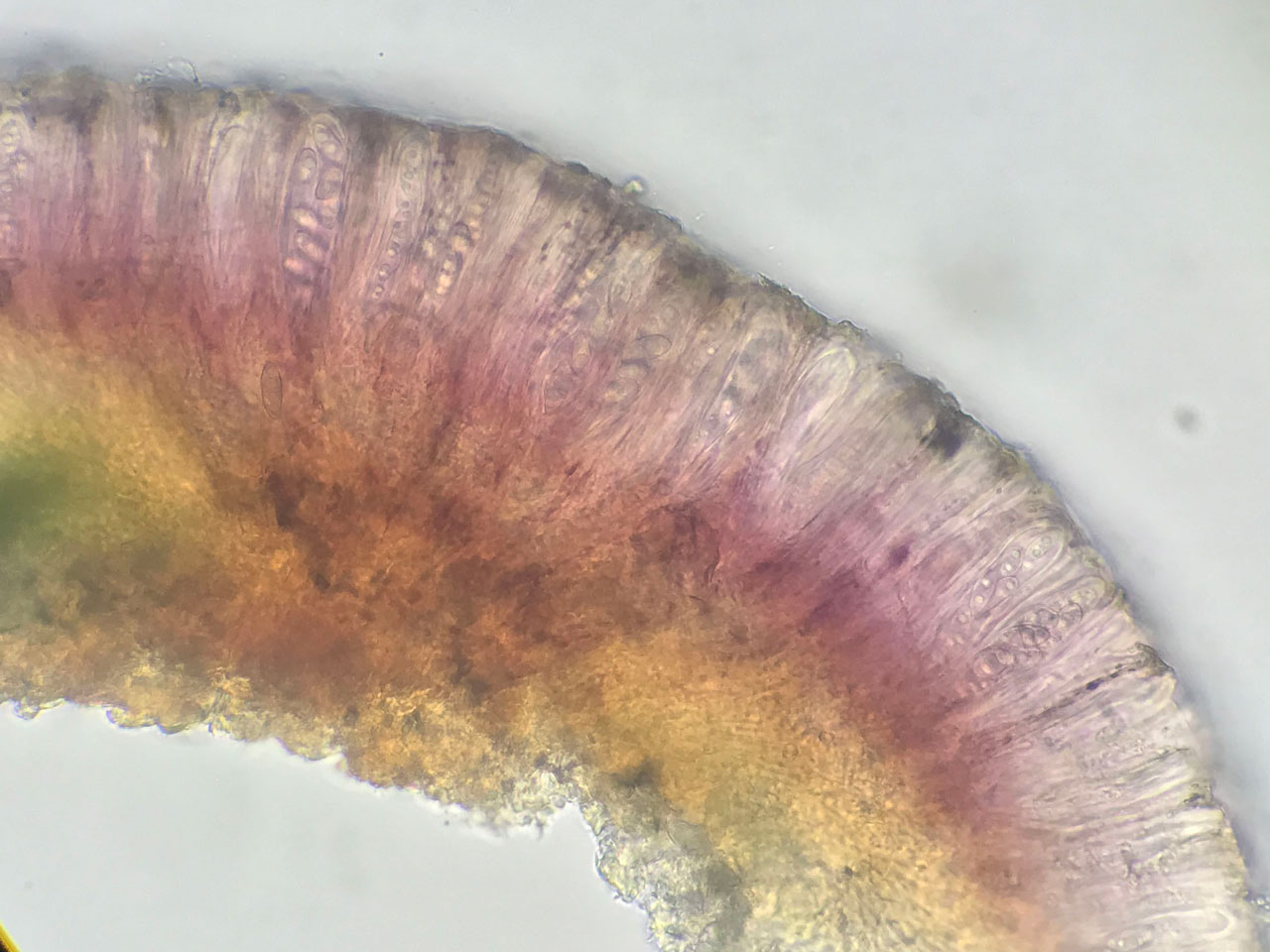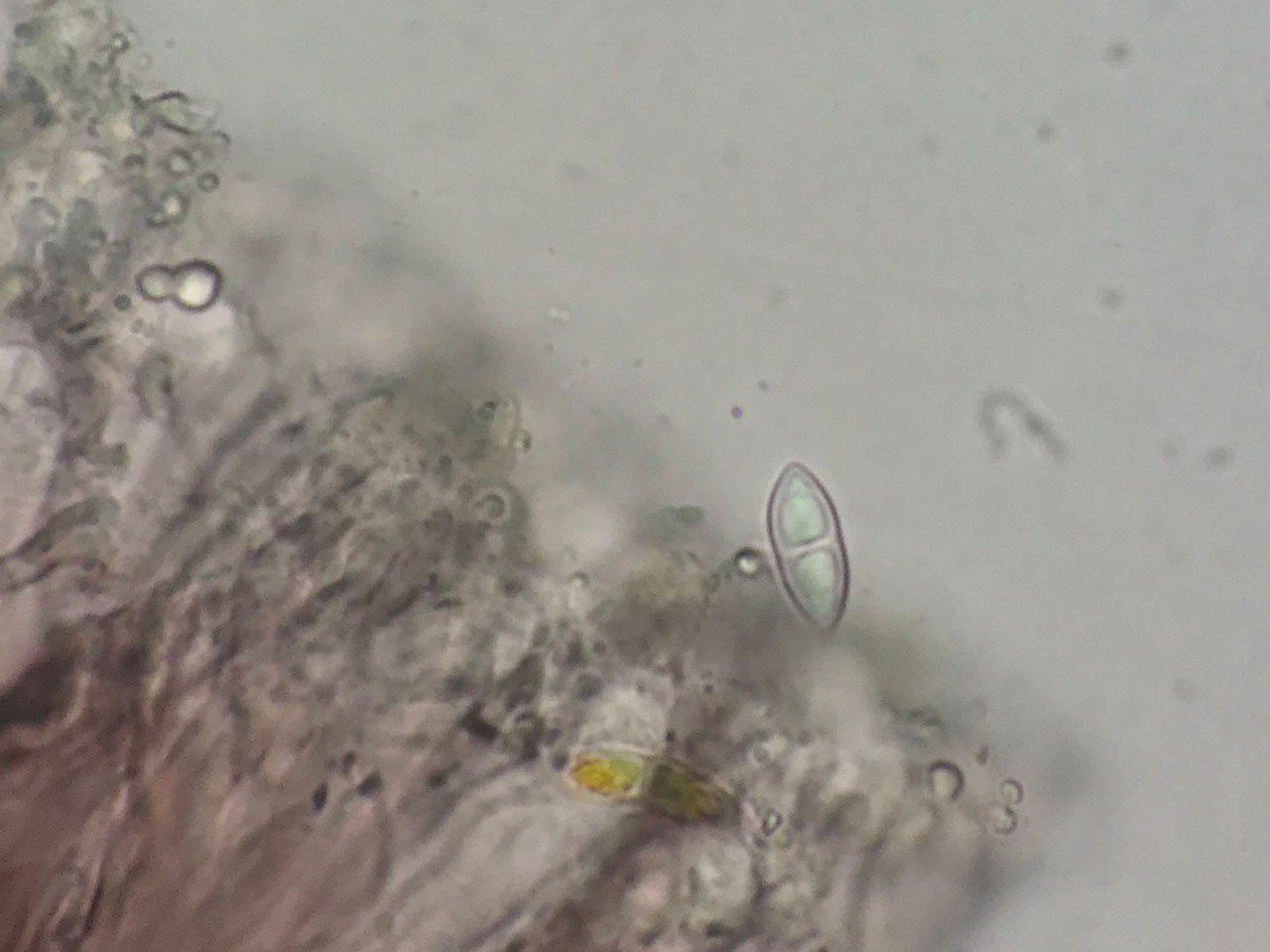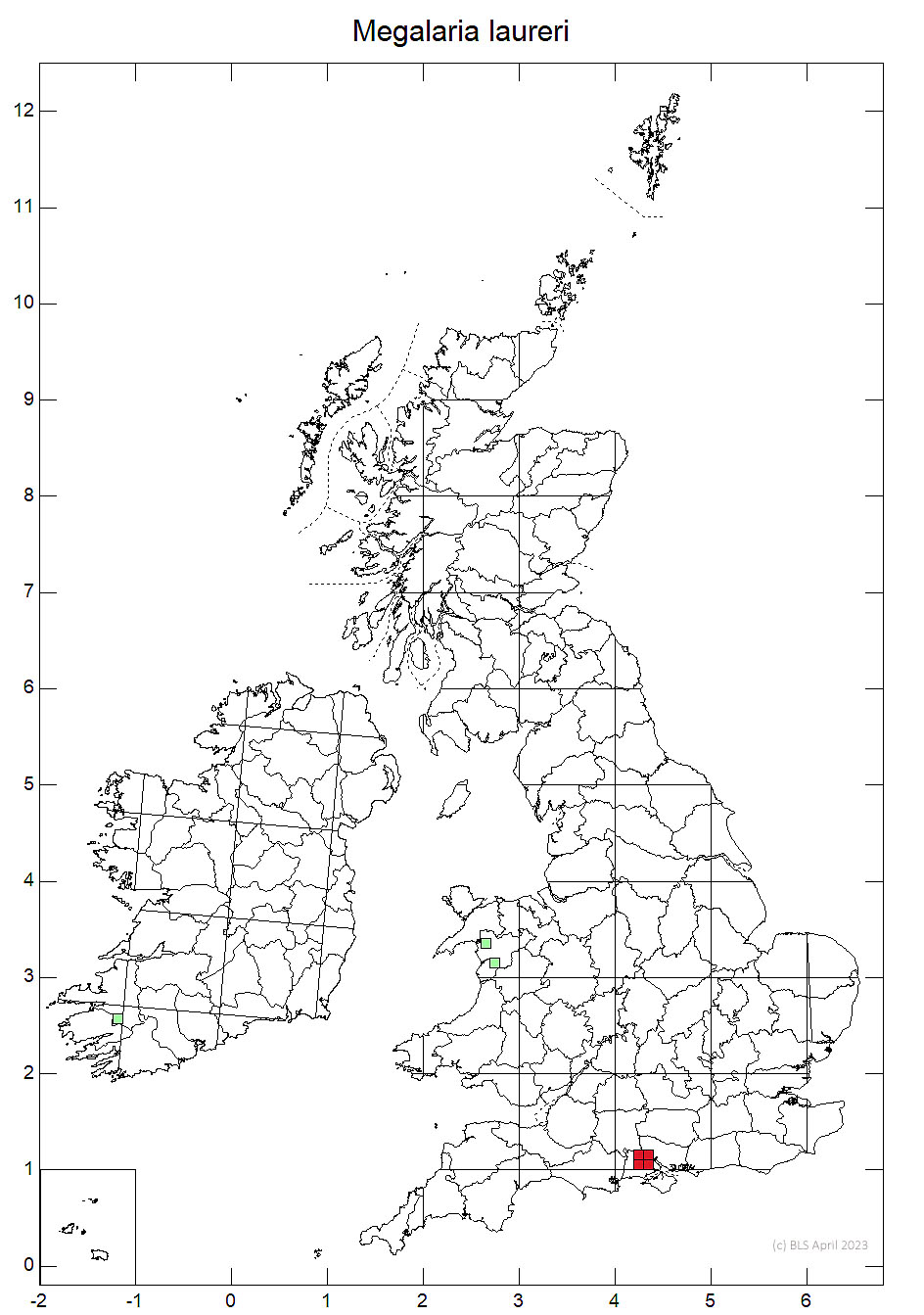A rare lichen confined to veteran Beeches in the New Forest, Hampshire, but with an old record from Killarney in south west Ireland. Occupies stable late succession communities in raintracks dominated by Enterographa crassa with Pyrenula chlorospila, Pertusaria hymenea and the liverwort Metzgeria furcata. Superficially similar to Lecidella elaeochroma but with a grey-green to whitish thallus and a very distinctive pale grey apothecia margin contrasting with the dark grey-black disk. This very rare species should not be knowingly collected.
Thallus whitish to grey-green, rimose, thin and smooth, or to 150 μm thick with a granular-warted surface; prothallus fimbriate, white, rarely visable, thallus typically delimited a black antagonism line; photobiont cells 6–14 μm diam. Apothecia 0.4–1.1 mm diam.; disc flat to slightly convex; true exciple shallow, often paler than the disc, colourless or sometimes brownish (concolorous with the epithecium) at the upper outer edge, at base of apothecium often concolorous with the hypothecium, swelling in K, the hyphae distinctly radiating, branched and anastomosing, 1.5–2 μm diam., without swollen ends; epithecium dark purple-brown, K+ purplish, N+ red, sometimes with additional patches of greenish, K+ green, N+ red pigment; hymenium 65–80 μm tall, colourless to pale purple brownish; hypothecium purple-red, K+ purple in the upper part (subhymenium); lower part pale golden-brown, K–; paraphyses 1.3–1.7 μm diam., unbranched, the apices clavate to 3 μm diam., cemented by adhering pigment. Asci Bacidia-type, with a distinct apical cushion. Ascospores 12–18 × 5–7 μm, ellipsoidal to fusiform-ellipsoidal. Pycnidia not found. Thallus C–, K+ pale yellow, Pd–, UV–.
Superficially resembles some morphs of the common Lecidella elaeochroma, which can be readily distinguished using chemical reactions. The pale margin contrasting with the darker disk is distinctive when well-developed, but morphs with less contrasting margins exist and are more difficult to pick out.
On the trunks of old Beech in rain tracks in old growth woods, with an old record from Oak. In the New Forest strongly associated with rain tracks on veteran Beech trees. Sanderson (1999) found it on Beech trees between 1.25 – 4.39m girth, with 45% being formerly pollarded. The ex-pollards dominated the larger girths but with maiden trees predominant in the smaller size classes, indicating historic colonisation from one generation of trees to another and no high dependance on continued pollarding. It was always found with abundant Enterographa crassa and some Pyrenula chlorospila, Pertusaria hymenea and the liverwort Metzgeria furcata. The presence of constant Metzgeria and other bryophytes indicates that M. laureri occupies the damper extremes of Enterographa crassa – Pyrenula chlorospila communities where it is grading into bryophyte dominated communities. The associated species from 26 quadrats in the New Forest in 1999 are listed below with constancy classes.
| Species | Species cont. | ||
| Enterographa crassa | V | Flavoparmelia caperata | I |
| Metzgeria furcata | V | Frullania fragilifolia | I |
| Pertusaria hymenea | V | Frullania tamarisci | I |
| Pyrenula chlorospila | V | Isothecium myosuroides | I |
| Lecanora chlarotera s. lat. | III | Lecidella elaeochroma | I |
| Thelotrema lepadinum | III | Lepra albescens | I |
| Graphis scripta s. lat. | II | Lepra multipuncta | I |
| Hypnum andoi | II | Loxospora elatina | I |
| Lepraria incana s. lat. | II | Lepraria incana s. lat. | I |
| Opegrapha vulgata | II | Mycoporum antecellens | I |
| Rinodina roboris | II | Neckera complanata | I |
| Snippocia nivea | II | Pachyphiale carneola | I |
| Acrocordia gemmata | I | Phaeographis dendritica | I |
| Alyxoria varia | I | Phlyctis argena | I |
| Anisomeridium biforme | I | Pyrenula macrospora | I |
| Arthonia atra | I | Pyrenula nitida | I |
| Catinaria atropurpurea | I | Pyrrhospora quernea | I |
| Cliostomum griffithii | I | Thelopsis rubella | I |
| Coniocarpon cinnabarinum | I | Zwackhia sorediifera | I |
| Dendrographa decolorans | I | Zygodon rupestris | I |

Very rare. S. England (Hampshire, New Forest), formerly Ireland (Killarney).
A very rare lichen, which is threatened and old growth dependant across Europe. Only ever recorded from The New Forest in England. It potentially occurred in other old growth Beech woods in the south east but, if so, it is long lost to pollution and enclosure of pasture woodlands. Several population counts or estimates have been made in the New Forest over the years, representing the known British population:
- 1994: 26 trees in six woods (Sanderson, 1994).
- 1999: 28 (five new, 3 three lost) trees in six woods (1 lost 1 new) (Sanderson, 1999).
- 2009: rough estimate of 48 - 121 trees from plot sampling for Enterographa elaborata (Sanderson, 2009).
- 2000-2023: 66 10m grid squares (effectively trees, but some double counting possible) & 17 1km grid squares (BLS Database).
Active colonisation of new trees has been observed as well as losses, the latter from tree death and developing wound tracks. New colonisation has been observed into raintrack communities developing within healing wound tracks and on to Beeches formerly heavily shaded by Holly but recently opened up by conservation Holly cutting. The New Forest sites are reasonably secure if there are no drastic changes in management. Shade from Holly is a potential threat here, but an active programme of Holly pollarding is containing this (Sanderson, 2019).
Britain: Endangered & International Responsibility Species
England: Section 41 species
Cannon, P., Aptroot, A., Coppins, B., Ertz, D., Sanderson, N., Simkin, J. & Wolseley, P. (2021). Arthoniales: Roccellaceae, including the genera Cresponea, Dendrographa, Dirina, Enterographa, Gyrographa, Lecanactis, Pseudoschismatomma, Psoronactis, Roccella, Schismatomma and Syncesia. Revisions of British and Irish Lichens 16: 1-22.
Sanderson, N. A. (1994) An Ecological Survey of the Lichens Catillaria laureri and Parmelia minarum in the New Forest, Hampshire. Second Report. A Botanical Survey & Assessment report to Hampshire Wildlife Trust.
Sanderson, N. A. (1999) New Forest Rare Lichen Monitoring Project. (Catillaria laureri, Parmelia minarum and Enterographa elaborata). A report to Hampshire Wildlife Trust.
Sanderson, N. A. (2009) A Species Dossier for Fancy Writing Enterographa elaborata in Britain. A report by Botanical Survey & Assessment to Natural England.
Sanderson, N. A. (2019) New Forest Holly Management and Epiphytic Lichen Conservation 2019. A Botanical Survey & Assessment report to Natural England, Forestry Commission & National Trust.
Text by Neil A Sanderson, based on Cannon et al (2021) & Sanderson (1999)
